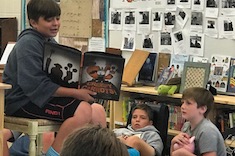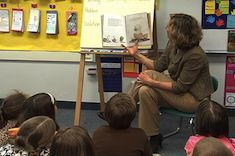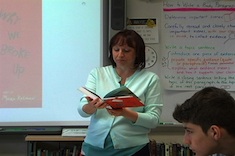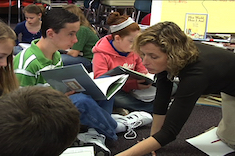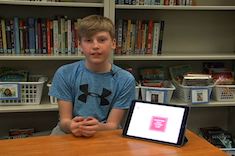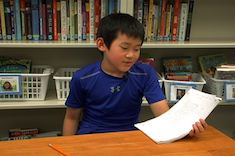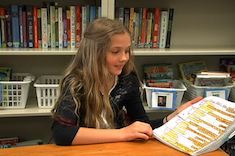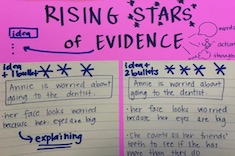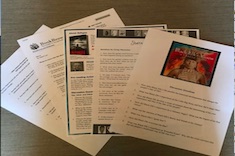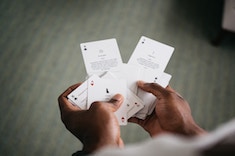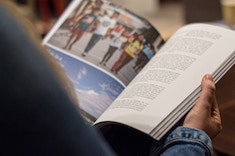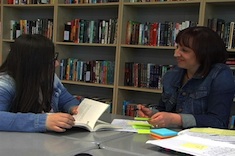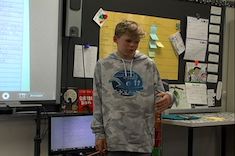Teaching Reading
Our contributors lead reading workshops in classrooms with creative flair. Over the past 12 years, we've filled our site with loads of suggestions, tools, and tips for using engaging books throughout the curriculum to hook kids on reading. Here is where you will find many stories of successful and not-so-successful workshop days, and what we learned from them. We bring these stories to life through hundreds of video examples.
Latest Content
Moving from Interactive Read Alouds to Book Clubs
Tammy Mulligan shares how teachers can move seamlessly from thoughtful conversations during whole-class read alouds to lively book clubs.
Do Students Need to Love the Books We Read Aloud?
Franki Sibberson asks a critical question: Do students need to love the read alouds we share in classrooms? She works to move students beyond shallow like/don’t like responses to books.
Read Aloud in Middle School
Katherine Sokolowski values read aloud for her middle school students and struggles to find time for them. Her solution? A picture book a day, better known as the #bookaday activity.
Grand Conversations and Read Aloud
Are your conversations during read aloud stilted or shallow? Tammy Mulligan recommends weekly “grand conversations” to spark more thoughtful talk. She provides the tools you need to get started in your classroom.
Back-Channel Conversations During Read Alouds
Christy Rush-Levine considers some of the “underground” ways in which she converses about books at conferences and on social media, and decides to set up a back channel for similar conversations about read alouds in her classroom.
Interactive Read Aloud and the Whole-Class Notebook
Tammy Mulligan enhances the quality of the class read aloud and student discussions with the use of a whole-class response notebook.
Speed Reading
Adolescent learners can face daunting reading loads in high school that they need to tackle at home. Jen Schwanke has tips for how teachers and parents can work together to help teens develop strategies for dealing with a lot of complex reading quickly.
Read-Aloud Annotations: Google Slides
In this video series, Franki Sibberson’s fifth graders share their strategies for annotating the class read aloud. In this installment, Antonio shares his Google Slides.
Read-Aloud Annotations: Google Docs for Questions
In this video series, Franki Sibberson’s fifth graders share their strategies for annotating the class read-aloud. In this installment, Lauren uses Google Docs to record questions to explore as she listens.
Read-Aloud Annotations: Expectation and Reality
In this video series, Franki Sibberson’s fifth graders share their strategies for annotating the class read-aloud. In this installment, Lizzie uses her notebook to focus on expectations and reality for characters, especially when it comes to stereotypes.
Read Aloud Annotations: Using Google Slides to Focus
In this video series, Franki Sibberson’s fifth graders share their strategies for annotating the class read-aloud, In this installment, Reagan uses Google Slides to focus her thoughts and analyze different characters.
Read-Aloud Annotations: Thoughts to Themes
In this video series, Franki Sibberson’s fifth graders share their strategies for annotating the class read-aloud. In this installment, Stone uses Google Slides to record thoughts and tease out themes.
Read Aloud Annotations: Predictions
In this video series, Franki Sibberson’s fifth graders share their strategies for annotating the class read aloud. In this installment, Sharvari uses Google Slides with text boxes to record predictions and thinking.
Read Aloud Annotations: Characters and Intentions
In this video series, Franki Sibberson’s fifth graders share their strategies for annotating the class read aloud The Girl Who Drank the Moon. In this installment, Ben creates a graph in his notebook to record characters and intentions that are emerging in the story.
Read-Aloud Annotations: Notebook Predictions
In this video series, Franki Sibberson’s fifth graders share their strategies for annotating the class read aloud, The Girl Who Drank the Moon. Students have their choice of using notebooks or tech devices, and can pick any strategy that helps them make sense of the story. In this installment, Hannah shares her notebook where she highlights the setting and characters, as well as makes predictions.
Unadulterated Reading
Just reading. Pure, unadulterated reading. That’s the reading homework that matters most in the long run. Stephanie Affinito explains why.
Reading Bingo
Gretchen Schroeder has developed a fun version of Reading Bingo to help students explore their identity as readers. The activity includes clever social media inspired options like creating memes and “bookstagram” posts.
Linking Evidence to Reading Response in First Grade
Tara Barnett and Kate Mills are discouraged by the random and idiosyncratic responses to reading they are seeing among first graders. They implement a series of lessons to help students move to evidence-based reading responses.
Readers Want to Respond
Matt Renwick is surprised when his son completes a reading quiz that isn’t required, and finally realizes it’s all about reading response.
The Power of Similes
If you want stronger poetry from students, a good starting point might be to explore how to write a powerful simile. Gretchen Schroeder explains how she helps her high school students play with and create better similes.
Reading The Crossover: Fourth-Grade Reading Group
Gigi McAllister leads a group of boys who are just starting the novel in verse The Crossover in her fourth-grade classroom.
Evidence Claims in a Middle School Small Group
Christy Ruth-Levine leads a small group of eighth graders as they explore how to include textual evidence in their literary analysis essays.
Readers’ Guides: Helping Students Think About Informational Text
Suzy Kaback finds the task of creating readers’ guides helps students in the intermediate grades think about evidence in texts in more sophisticated ways.
Hunting for Textual Evidence
Gretchen Schroeder finds just telling her high school class to include textual evidence when making points and arming them with sticky notes leaves many students bewildered. She regroups and comes up with activities to scaffold their understanding of what makes for valid evidence.
Teaching Tone: Deal Me In
Gretchen Schroeder’s high school students are surprised to see a deck of cards on their supply list. The cards are a tool for teaching the vocabulary of tone in creative ways.
Fear of Reading
Gretchen Schroeder reflects on why some of her students have developed a fear of reading by the time they reach high school.
Cause and Effect: Conferring with Olivia
Christy Rush-Levine confers with Olivia about the principle of cause and effect in the novel she is reading.
Linking Pictures and Text: Conferring with Ava
Katrina Edwards begins her conference with first grader Ava by having her share what she learned from a picture walk through a simple text, and then she helps her use pictures to decode text while reading.
Four-Step Reading Conferences
Christy Rush-Levine emphasizes “reflaction” in her reading conference protocol—reflection that leads to action for her students. Download the Reflaction (reflection + action) Form to use with students.
Student-Led Minilesson: Connecting Facts from Different Sources
Lucas leads a minilesson in Franki Sibberson’s fifth-grade class on connecting facts from different sources.
Browse Content By
Type
Category
- Assessment Tools
- Big Fresh Archives
- Booklists
- Choice Numeracy
- Classroom Design
- Common Core
- Community Building
- Conferring
- Content Literacy
- Digital Literacy
- English Language Learners
- Equity
- Family Relations
- Free Samples
- Guiding Groups
- Leadership
- Literacy Coaches
- Mentor Texts
- Minilessons
- New Teacher Mentors
- Podcasts
- Poetry
- Quote Collections
- Reading Strategies
- Self Care
- Struggling and Striving Learners
- Talking and Listening
- Teacher Study Groups
- Teaching Reading
- Teaching Writing
- Word Study and Vocabulary
Author
- Melissa Quimby
- Nawal Qarooni
- Gwen Blumberg
- Julie Cox
- The Lead Learners
- Hannah Tills
- Josie Stewart
- Ruth Metcalfe
- Mallory Messenger
- Becca Burk
- Jodie Bailey
- Vivian Chen
- Mary Brower
- Tiffany Abbott Fuller
- Stephanie Affinito
- Ruth Ayres
- Leigh Anne Eck
- Heather Fisher
- Shari Frost
- Julie Johnson
- Suzy Kaback
- Gigi McAllister
- Shirl McPhillips
- Melanie Meehan
- Cathy Mere
- Debbie Miller
- Tara Barnett and Kate Mills
- Tammy Mulligan
- Dana Murphy
- Bitsy Parks
- David Pittman
- Brenda Power
- Heather Rader
- Matt Renwick
- Mandy Robek
- Christy Rush-Levine
- Gretchen Schroeder
- Jen Schwanke
- Brian Sepe
- Katherine Sokolowski
- Stella Villalba
- Jennifer Vincent
Grade Level
Choice Literacy Membership
Articles
Get full access to all Choice Literacy article content
Videos
Get full access to all Choice Literacy video content
Courses
Access Choice Literacy course curriculum and training



